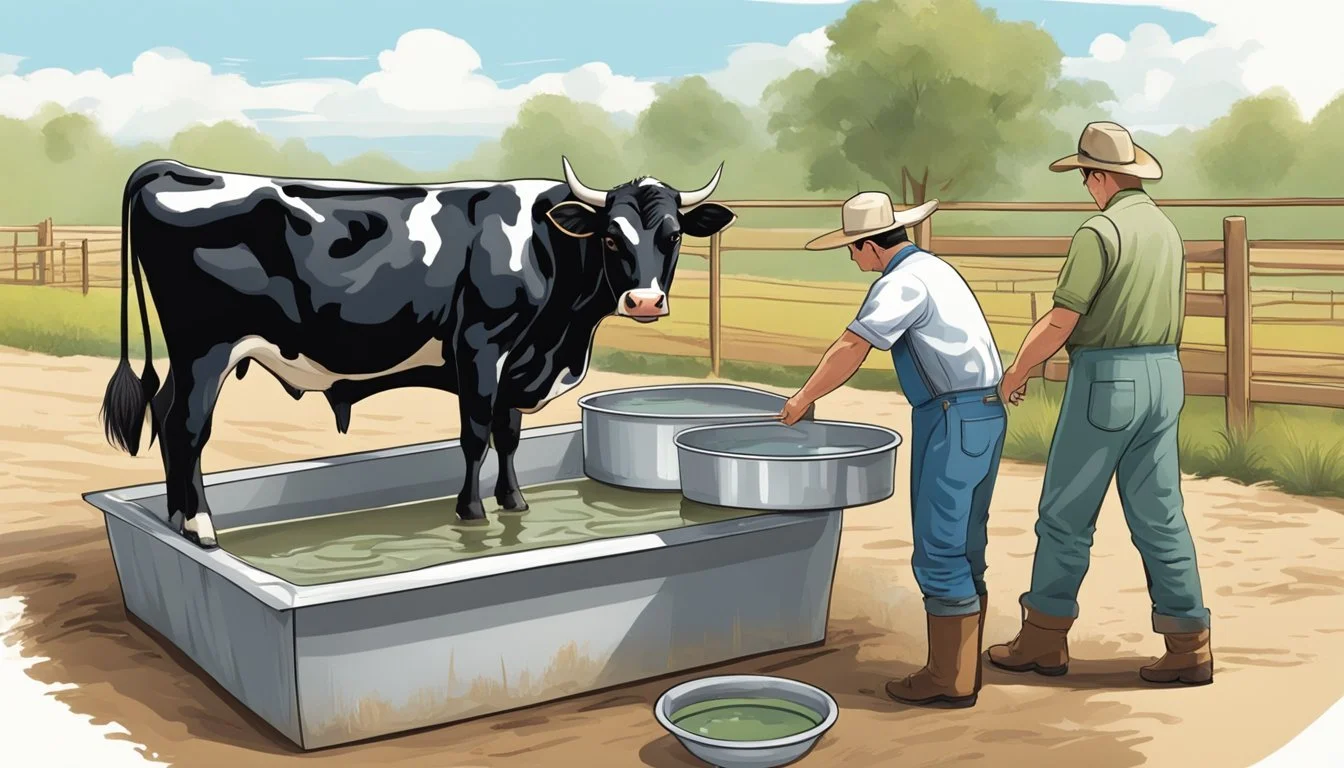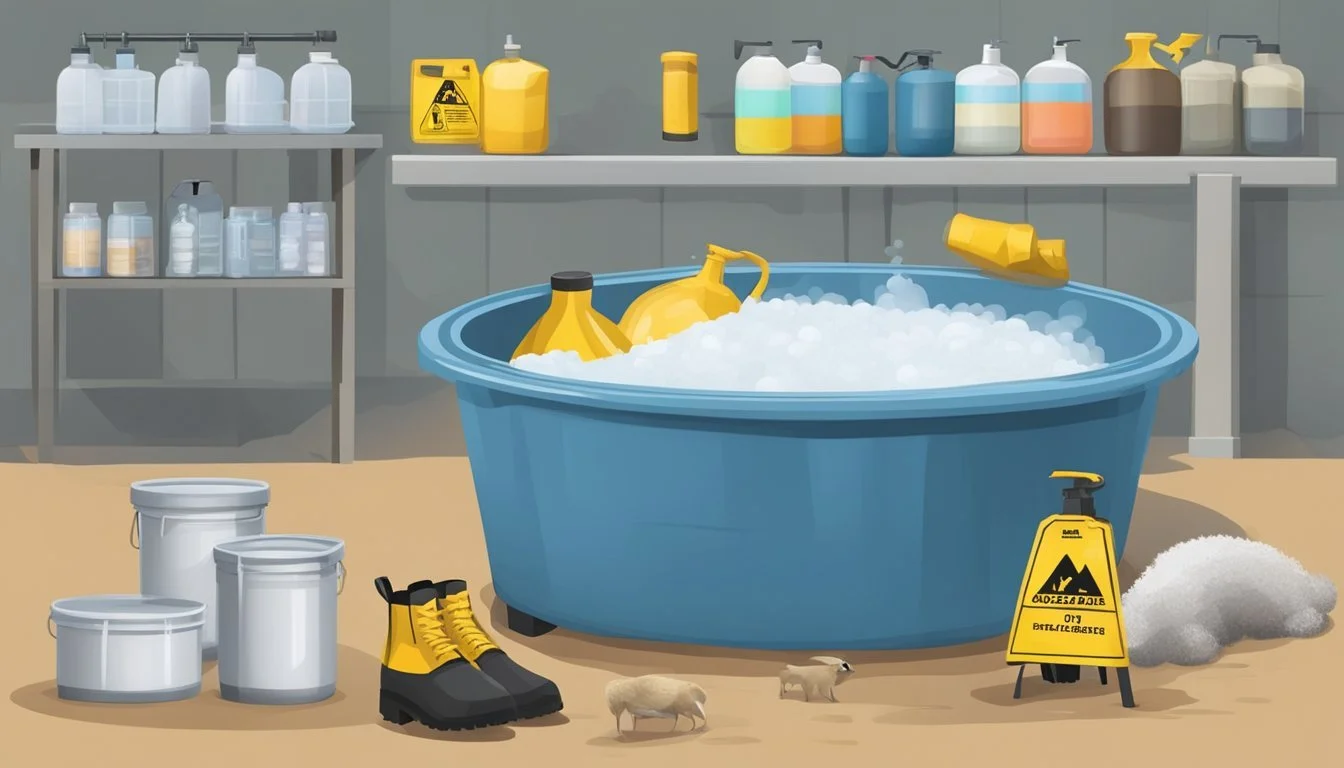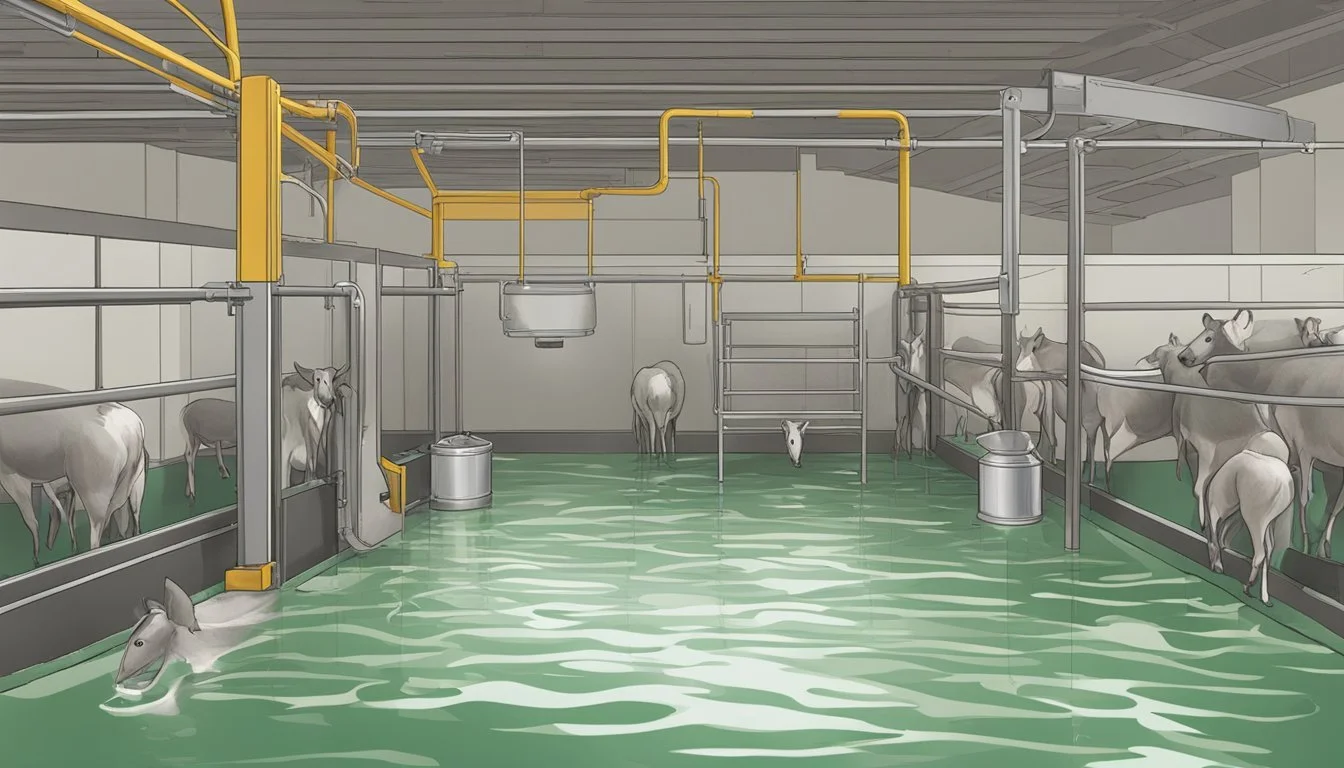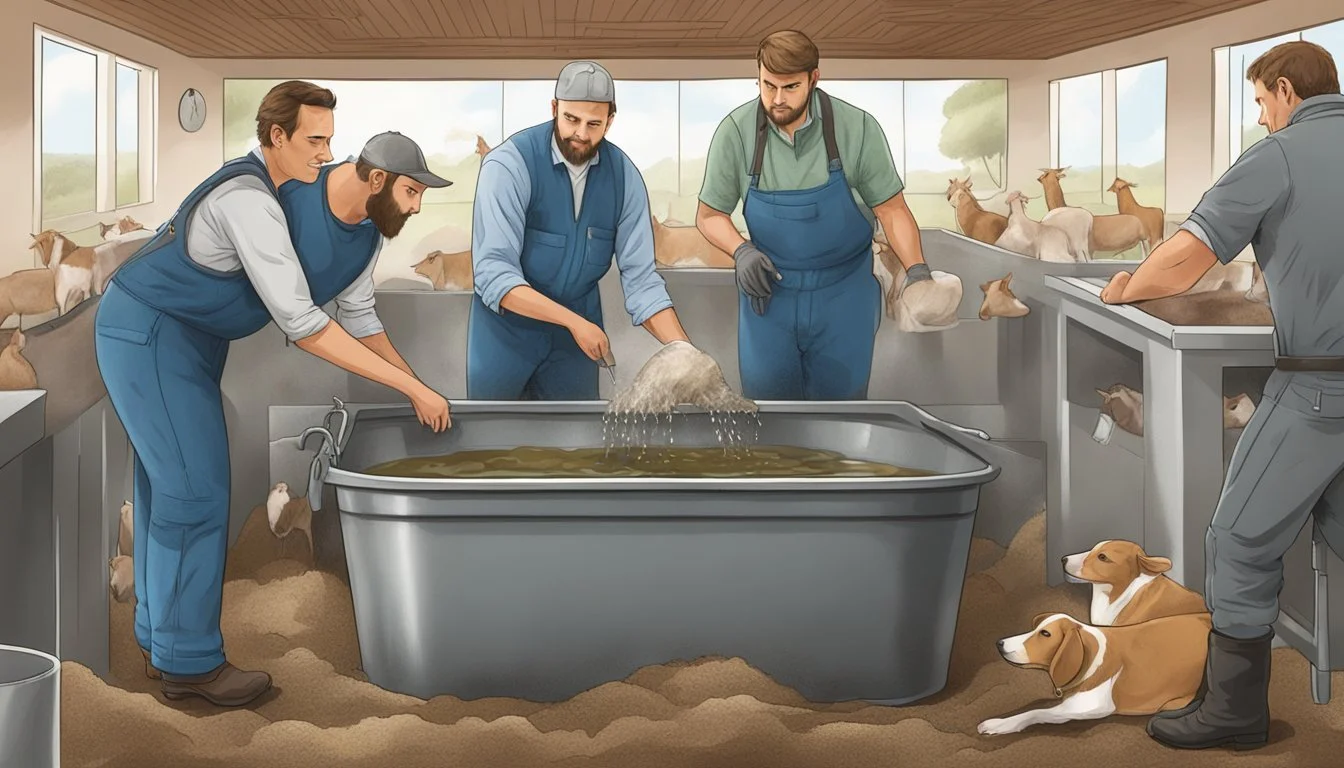The Ultimate Guide to Using a Livestock Foot Bath
Safeguarding Hoof Health on Your Homestead
Maintaining the health of livestock is critical for any homesteader, and hoof diseases pose a significant challenge that can lead to decreased production and increased costs. Among the most effective preventive measures is the use of a livestock foot bath, an essential tool on farms for combating hoof ailments such as foot rot and digital dermatitis. Incorporating a foot bath into the routine care of animals can prevent the onset and spread of such diseases, ensuring that the livestock is not only healthy but also comfortable.
The science behind the proper use of a livestock foot bath involves a combination of appropriate dimensions, regular maintenance, and correct solution mix. Studies and expertise recommend that for effective treatment, a foot bath solution should maintain a certain depth and pH level that corresponds to the healthy skin pH range of cattle. Correct use and regular changing of the solution also maximize the efficacy of the foot baths in combating infectious lesions.
Tailoring these preventive practices to fit the needs of individual homesteads can vary, but the underlying principles remain the same. When executed with precision, livestock foot baths become a vital component in a holistic approach to animal care, enhancing hoof health, and by extension, the overall well-being of the farm's animals.
Understanding Hoof Health
Maintaining hoof health is vital in livestock management as it directly impacts animal mobility, productivity, and overall well-being. The onset of hoof diseases can lead to discomfort and lameness, reducing the quality of life for the animal. Prompt attention to hoof care can prevent many common diseases.
The Importance of Hoof Care
Hoof care is paramount to preventing hoof diseases that can develop from poor management and unsanitary conditions. Regular hoof trimming and proper foot bath practices are essential to maintain the structural integrity of the hoof and to prevent the overgrowth that can lead to lesions. Livestock with healthy hooves are less susceptible to lameness, which can affect their ability to graze, mate, and achieve optimal growth or milk production.
Common Hoof Diseases
Livestock can suffer from several common hoof diseases, each with distinct causes and symptoms:
Digital Dermatitis: Also known as hairy heel warts, this is a painful skin disease that typically affects the area around the heel.
Foot Rot: A bacterial infection that causes inflammation between the toes, leading to severe pain and lameness.
Sole Ulcer: Usually occurring on the sole of the hoof, this condition can cause significant discomfort and lead to secondary infections.
Infectious hoof diseases such as digital dermatitis and foot rot are often spread in wet and dirty environments, highlighting the need for hygienic hoof care practices. Regular inspections and treating hoof lesions early are crucial in managing and preventing the progression of these diseases.
Basics of Foot Bathing
In the process of maintaining livestock health, especially for hoofed animals, the implementation of foot baths plays a crucial role. This section elucidates the foundational aspects of foot bathing, ensuring a clear understanding of its concept and the various types employed.
What Is a Foot Bath?
A foot bath is a treatment trough where livestock step into a solution designed to clean and disinfect their hooves. The primary goal is to prevent and manage hoof diseases by eliminating pathogens that can cause conditions like foot rot and digital dermatitis. Essential to its efficacy, the foot bath must contain an appropriate depth of water mixed with disinfectants such as copper sulfate or formalin, and its pH levels must be regulated to optimize the disinfectant's potency.
Optimal Depth: 4-5 inches (10-12 cm)
Disinfectants commonly used: Copper Sulfate, Formalin
pH Levels: Maintained to enhance disinfectant effectiveness
Types of Foot Baths
There are various foot bath types, each designed with specific features to cater to different requirements and herd sizes.
Portable Foot Baths:
Made of plastic or rubber
Easy to move and ideal for temporary setups
Permanent Foot Baths:
Constructed into the concrete floor
Made from concrete or stainless steel for durability
Non-slip base to ensure animal safety
Alternative Foot Baths:
Utilize sprays like Hoof Sol Spray in lieu of full immersion
Hoof Sol Bath for a deeper treatment approach
Regardless of type, farmers often integrate additives like Hoof Sol Bath for enhanced hoof care. Each design must focus on the safe immersion of hooves up to the hairline, while considering efficient resource use, such as minimizing water and chemical use through narrower, longer baths.
Implementing Foot Bath Protocols
Implementing effective foot bath protocols is essential for preventing and treating hoof diseases in livestock. This includes proper preparation, maintaining specific frequencies, and using the correct solution concentrations.
Preparation and Positioning
Before introducing animals to the footbath, one must ensure the bath dimensions adhere to recommended sizes. A typical footbath should have a minimal depth of 4 inches to ensure adequate coverage of the hoof. Optimal dimensions, such as a width of 30 inches and length of 72 inches, permit ease of movement and complete immersion of hooves. The footbath should be positioned on a level surface with a minimal slope to prevent spilling and ensure even solution distribution.
Frequency and Timing
The frequency of foot-bathing depends on the condition being treated or prevented; it is generally conducted one to three times per week. Timing plays a critical role—in periods of high infection risk, daily foot-bathing may be necessary. It's important to schedule footbathing when the cattle are being moved for other reasons to reduce stress and ensure compliance.
Footbath Solution and Concentration
The footbath solution should have a pH maintained between 3.5 to 5.5, matching normal skin pH levels to optimize hoof health. The typical treatment concentration for disinfectants is a 5% solution, ensuring the right balance between efficacy and safety for the livestock. When preparing the solution, use precise measurements and follow the manufacturer’s instructions to ensure effectiveness for treating or preventing diseases such as foot rot and digital dermatitis. Always use fresh solution to prevent contamination and ensure consistent results.
Foot Bath Effectiveness and Management
In managing hoof disorders, the role of a well-maintained foot bath program is paramount. Data underscores that a rigorous and regularly assessed approach is key to using foot baths as an effective preventive measure.
Assessing Efficacy
The effectiveness of a footbath can be determined by its ability to reduce the incidence of infectious hoof lesions. Key factors influencing this are:
Consistency of use: The footbath should be integrated into the livestock's routine.
Solution composition: Various disinfectants can be used, and their efficacy needs monitoring.
Cleanliness: A dirty footbath can become a source of infection rather than prevention.
Farmers should conduct periodic reviews of their footbath program, evaluating health outcomes, and adjusting the type and concentration of footbath solutions based on observed results.
Footbath Maintenance
To ensure footbaths remain effective:
Clean regularly: Remove organic matter that can inactivate disinfectants.
Check solution depth: Maintain a minimum depth of 4 inches to ensure proper coverage of the hoof.
Solution change frequency: Replace the footbath solution as per the recommended guidelines, which is often after 200-300 cows have passed or when it becomes visibly dirty.
Footbath design is also important; it should minimize waste while allowing all animals to benefit from the treatment.
Adjusting Protocols
The footbath management protocol should be dynamic, adapting to:
Farm Size: Smaller farms may need to change the solution more frequently due to a higher relative accumulation of contaminants.
Health Data: Track the hoof health of livestock and adjust frequency and solution concentration accordingly.
Weather Conditions: More rigorous footbath routines may be needed during wet conditions when hoof issues are more prevalent.
By maintaining focus on these variables, farmers can optimize their footbath programs, leading to better hoof health and overall productivity.
Animal Health and Welfare Considerations
In addressing hoof diseases, it is crucial to prioritize animal health and welfare considerations. These focus on mitigating lameness and ensuring a high-quality hoof care protocol.
Impact on Mobility and Well-being
Hoof diseases severely affect an animal's mobility, leading to lameness, which can compromise their overall well-being. Lameness, often seen in domestic livestock, can cause pain and restricted movement, thereby impacting an animal's ability to graze, mate, and integrate with the herd. Establishing an effective foot bath routine is pivotal in preventing infectious hoof diseases such as foot rot and digital dermatitis.
Key benefits of foot baths:
Reduction in the incidence of hoof diseases
Enhanced animal mobility and quality of life
Frequency and solution used in the foot bath:
Regular use: Recommended at least once or twice weekly for prevention.
Post-diagnosis: More frequent treatments as part of a veterinarian-approved treatment plan.
Solutions: Often include copper sulfate or formalin; also, consider gentler options like organic-acid-based solutions.
Hoof Trimming and Care Regimen
Alongside foot baths, a regular hoof trimming and care regimen is essential. Hoof trimming is a crucial component in maintaining proper hoof shape and function, preventing overgrowth and abnormal wear patterns which can lead to lameness.
Elements of hoof care protocol:
Regular inspections: Monitor hooves for early signs of disease or injury.
Scheduled trimming: Perform hoof trimming every 6 to 8 weeks, or as recommended by a hoof care specialist.
Tools and Techniques:
Use specialized hoof trimming tools: knives, trimmers, and abrasive wheels.
Follow proper trimming techniques to avoid causing pain or injury to the animal.
Good hoof hygiene is supported by the following:
Clean housing: Maintain clean, dry, and appropriately bedded living conditions.
Diet and nutrition: Provide a balanced diet to support hoof health and strength.
Farm and Herd Management
In managing a homestead, successful herd health stems from meticulous farm management practices, particularly when using a livestock foot bath. This involves strategic infrastructure setup and understanding the environmental influences on herd well-being.
Herd Size and Infrastructure
One must consider herd size when designing the farm's infrastructure for foot bath implementation. Smaller herds may need only one foot bath, while larger herds benefit from multiple stations to ensure each animal is treated without creating unnecessary congestion. Key infrastructure components include:
Pens: Adequate space for comfortable movement and access to the foot bath.
Holding Area: A designated zone where cows can gather pre and post treatment without stressing the animals.
Milking Parlour: Placement of foot baths near the milking parlour allows for seamless integration into the cows' routine.
Environmental Impacts and Herd Health
The farm environment directly affects the health of the herd. Poor environmental conditions, such as excessively wet or muddy pens, increase the risk of hoof diseases. A well-maintained foot bath system serves as a preventative measure, but one must also address environmental issues:
Cleanliness: Regular cleaning of pens and holding areas to minimize disease spread.
Water Management: Effective drainage systems to prevent standing water which can harbor bacteria.
Implementing these practices leads to healthier livestock and, consequently, more stable farm operations.
Safety and Chemical Usage in Foot Baths
Maintaining hoof health in livestock requires careful management of foot bath safety and chemical use. Proper use of disinfectants and awareness of chemical risks are vital.
Cautions with Chemical Treatments
When using chemical treatments to disinfect foot baths, it is essential to handle these substances with caution to prevent harm to both animals and handlers. Certain chemicals can act as carcinogens, posing a serious health risk. Handlers should always wear protective gear, such as gloves and eye protection, and ensure that the livestock are not exposed to high concentrations which could cause irritation or more severe health issues.
Chemicals commonly used in foot baths include:
Copper sulfate: Effective as a topical treatment but can be harmful in high doses.
Formaldehyde: Potent disinfectant with carcinogenic properties; use is increasingly regulated.
The frequency of changing foot bath solutions should also be monitored to maintain effectiveness in preventing infectious lesions and to reduce the risk of chemical burns from overexposure.
Alternatives to Hazardous Substances
Farmers are increasingly interested in non-hazardous alternatives for maintaining hoof health. These alternatives include:
Organic acids: Safer and often as effective as harsher chemicals.
Phytotherapeutic agents: Plant-derived substances offering a natural form of topical treatment without the risks associated with traditional chemicals.
Antibiotic foot baths: These can be effective but raise concerns about antibiotic resistance and should only be used under veterinary guidance.
Using alternatives can diminish the exposure to hazardous substances without compromising the foot bath's efficacy. It's essential, however, to still employ similar levels of diligence regarding the proper concentration and frequency of use, as even natural products can have adverse effects if misused.
Cost Considerations and Economic Impact
When implementing a livestock foot bath on a homestead, careful consideration of the costs involved and the potential impact on the overall productivity and profitability of your dairy operation are critical.
Calculating the Cost of Foot baths
To accurately budget for foot baths, one must factor in the initial investment and ongoing expenses. Costs typically include construction materials for the bath itself and the solutions used within it. For instance, a foot bath 20 inches wide and 12 feet long, with a depth of 4 inches, will hold around 50 gallons of solution. This demands precise calculation to ensure adequate solution, which impacts the frequency of change and the amount used. Additionally, the type of cleansing agent chosen, such as copper sulfate for controlling foot warts, will affect the overall expenses. Dairy farms must also account for labor and water costs associated with the use and maintenance of the foot bath.
Impact on Productivity and Profitability
The effectiveness of foot baths in preventing and controlling hoof diseases directly correlates with an increase in productivity. Healthy cows tend to have higher milk production rates. Conversely, hoof diseases can lead to decreased milk yields due to discomfort and reduced mobility. In the dairy industry, the cost of untreated hoof problems can extend to veterinary bills, decreased animal longevity, and even a potential impact on human health expenditures through zoonoses. A foot bath that is well-maintained and integrated into a comprehensive lameness prevention program is a valuable asset. It positions the homesteader to not only enhance the welfare of the herd but also secure the economic sustainability of dairy production on their farm.
Working with Professionals
When seeking to uphold the best standards in livestock hoof care, consultation with specialists and commitment to continuous training are paramount. These efforts ensure that farmers are equipped with the latest knowledge and techniques to prevent and treat hoof diseases effectively.
Consulting Veterinarians and Specialists
Farmers should engage with veterinarians who specialize in livestock to evaluate their current foot bath practices and provide tailored advice. A consulting veterinarian can assess the hoof health of the herd and recommend specific treatments or foot bath solutions. It is vital for farmers to have regular site visits from these specialists, ensuring that the livestock's environment and care routines are conducive to preventing hoof diseases.
Site Visits: Schedule regular check-ups with a veterinarian to assess hoof health.
Tailored Solutions: Obtain recommendations for foot bath solutions based on the herd's specific needs.
Continuous Education and Training
Investment in continuous education ensures that farmers and livestock handlers remain abreast of evolving best practices in hoof care management. For instance, attending workshops or seminars led by hoof care experts can impart new insights on foot bath dimensions, hygiene practices, and emerging treatments. Moreover, incorporating training into farm operations enhances the skillset of all personnel involved in animal care.
Workshops and Seminars: Attend industry events for the latest hoof care strategies.
Skill Development: Ensure all farm staff receive training on updated foot bath procedures and hoof care techniques.
Adapting to Different Farm Types
Livestock foot baths are an integral part of maintaining hoof health, but their design and usage vary considerably between dairy and beef cattle operations. Proper adaptation to the specific needs and constraints of each farm type ensures the effectiveness of these preventive and treatment measures.
Considerations for Dairy Farms
When considering foot baths for dairy farms, one must account for the high foot traffic and frequent milking cycles. Typically, these operations benefit from having a foot bath with minimal slope and water use—a design that both conserves resources and provides effective treatment. Here are specific recommendations:
Use a long, narrow foot bath to optimize results.
Whenever feasible, install two narrow baths side by side, a more economical solution for large herds than wider alternatives.
Ensure a consistent depth of at least 4 inches to maintain an adequate coverage of the solution.
Provide a bypass lane for dry cows or those not in need of treatment to avoid unnecessary exposure to chemicals.
Tailoring for Beef Cattle Operations
Beef cattle operations have different considerations, as the animals are often kept in varying environments from feedlots to pasture. For these operations:
Robustness of structure takes precedence, as beef cattle can present more stress on facilities.
Foot baths must be strategically placed to ensure all cattle pass through them, particularly those that are less frequently handled.
Opt for a simpler but durable design that suits the usually less intense treatment schedules compared to dairy farms.
Chemical concentration may vary, so monitor and adjust according to the lesser or greater frequency of foot baths than dairy cattle.
Conclusion
A rigorous and informed approach to foot bath management is essential for the prevention of hoof disorders such as foot rot and digital dermatitis on livestock homesteads. Consistent use of a well-maintained foot bath helps in maintaining healthy hooves, thus reducing the likelihood of lameness and associated ailments.
A successful foot bath regimen includes:
Correct Solution: Ensuring the solution maintains a pH of 3.5 to 5.5, mirroring healthy skin pH levels for optimal effectiveness.
Adequate Dimensions: As research suggests, foot baths should allow for multiple hoof immersions, with a length enabling at least two steps with each hoof.
Alongside the chemical balance and physical attributes of the bath, a comprehensive hoof health program includes frequent solution changes to address contamination and regular monitoring to adapt the treatment to the changing conditions of the herd.
By adhering to these principles, livestock owners can secure the well-being of their animals and the longevity and sustainability of their homestead operations. It's important that the practice of using foot baths is part of a whole-farm approach to animal welfare, which prioritizes vigilance, good husbandry practices, and routine hoof care assessments. A proactive stance in managing hoof health not only enhances animal well-being but contributes significantly to the overall success of a livestock enterprise.






